Sourdough Maple Bacon Bars
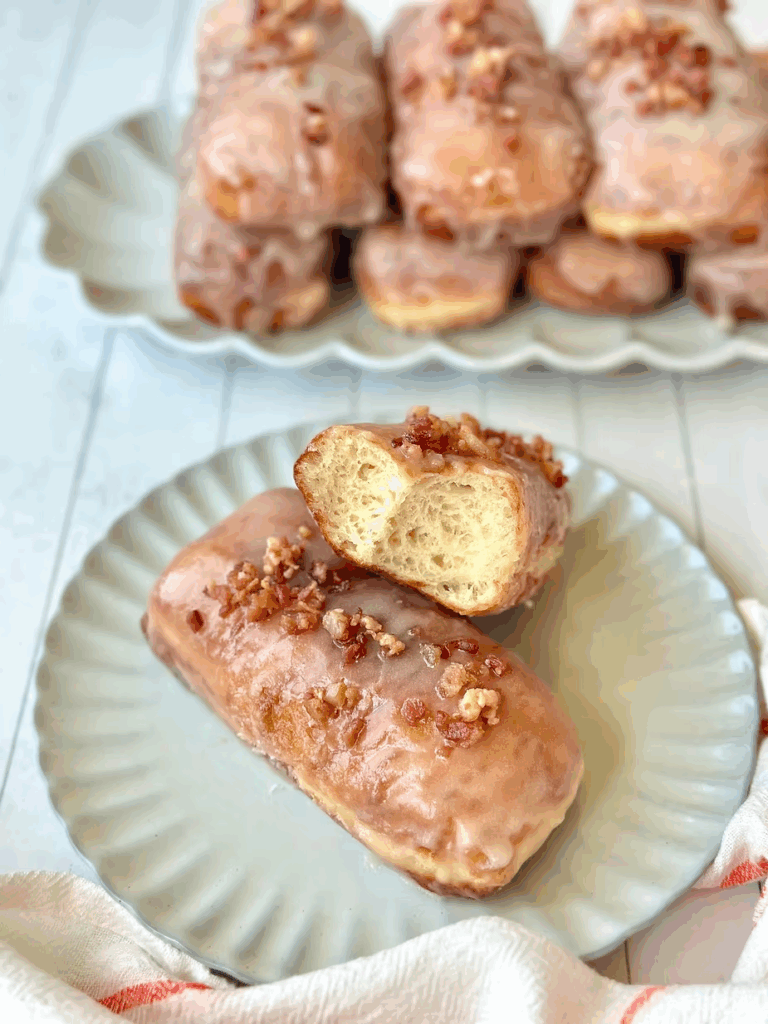
I don’t think I’ve ever met anyone that doesn’t like bacon- and bacon on top of a donut? Well sign me up!
These Sourdough Maple Bacon Bars are everything you didn’t know you were missing: pillowy soft, glazed with a buttery thick maple glaze, and finished with crispy bacon crumbles on top. One bite of these melt-in-your-mouth donuts, and you’ll be transported back to that small donut shop from your childhood!
Why You’ll Love This Recipe:
These donuts are ultra soft thanks to a Japanese-style tangzhong (cooked flour paste) and are naturally leavened with a sweet, bubbly sourdough starter. The result? Incredibly fluffy donuts with just the right amount of tang, fried until golden in coconut oil, and dipped in a rich maple glaze that sets beautifully topped with salty bacon for that perfect sweet and salty bite.
Versatile and easy to work around your schedule, you can make these in one day or fit it around your needs to stretch out the steps over the course of two days.
Why Use a Sweet Levain?
Milder flavor- the added sugar in the levain feeds the yeast while tempering the sourness of the sourdough. The sugar works to stabilize fermentation and works beautifully in enriched doughs.
Why Use a Tangzhong?
Tangzhong is a simple process of heating up milk with flour and creating a roux. Done in minutes, this process pre-gelatinizes the starches allowing the dough to hold more moisture. This process locks in moisture while also strengthening the dough, resulting in pillowy soft texture with an expanded shelf-life. This will give you yeasted results while keeping it sourdough!
*As an amazon affiliate, this post may contain affiliate links, which means I may receive a commission for qualifying purchases. I will only recommend products that I personally love and use.*
Tools You’ll Need:
- Stand mixer (optional)- for kneading dough.
- 1 medium and 1 small saucepan- for making tangzhong and glaze.
- Kitchen scale or measuring cups and spoons– for measuring ingredients.
- Rolling pin- for rolling out donuts.
- Pizza wheel or sharp knife– for cutting out donuts.
- Long ruler or tape measure (optional)- for measuring length and width of dough and donuts when shaping for precision.
- 12 6×4 parchment squares- I cut my own to make frying donuts easier.
- Deep pot or Dutch oven– for frying donuts.
- Frying thermometer– for keeping oil at 340–350°F. I strongly recommend using this tool to avoid burning I use this one linked here and love it https://amzn.to/4jHpwXH.
- Slotted spoon or chopsticks– to flip donuts. Here is the link for a slotted spoon I use https://amzn.to/4cLSO4F and chopsticks that are reusable https://amzn.to/42GyPzE.
- Cooling rack + paper towels– for drying donuts after frying.
- Wire rack– for draining excess glaze from donuts.
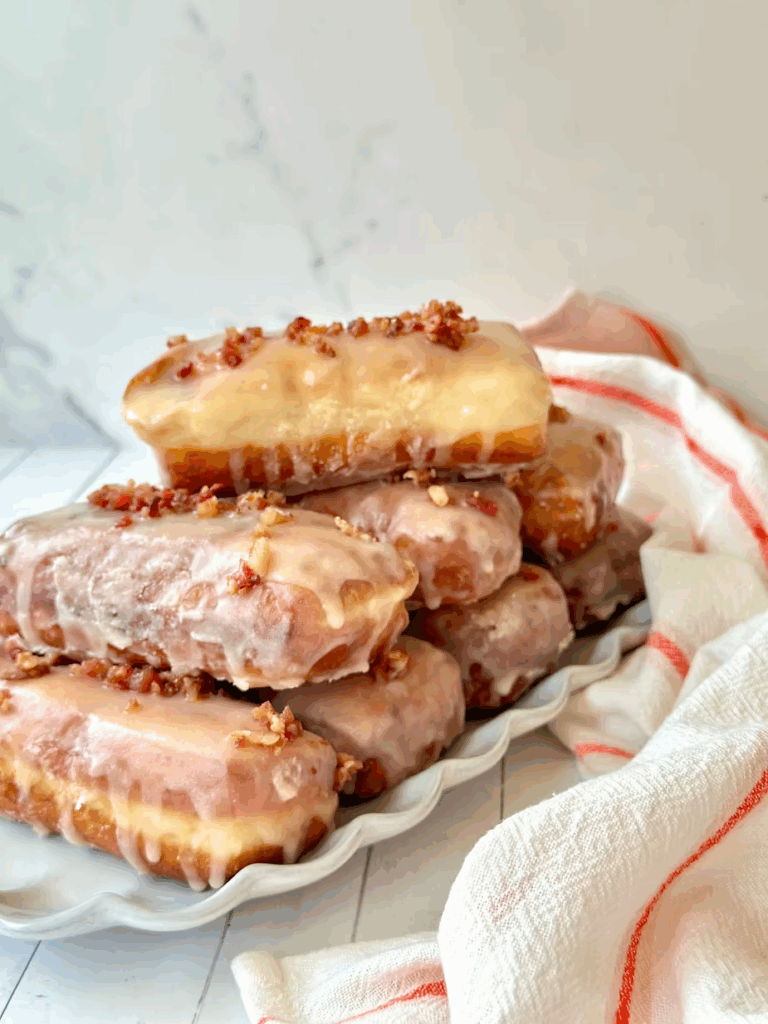
Gather Your Ingredients:
- Whole milk – milk enriches this dough making it soft and tender.
- Egg – adds tenderness and structure to the dough working as a binder.
- Unsalted butter – enriches dough and adds rich flavor to glaze.
- White Sugar – sweetens the dough and cuts the tang of the starter with a sweet levain.
- Honey – adds softness to the crumb and subtle floral note of sweetness (can substitute for sugar).
- Sea salt – balances sweet and sour flavors.
- Vanilla extract – for aromatic warmth and depth of flavor to dough and glaze.
- All-purpose flour– I recommend AP flour over bread flour to create a more tender crumb. The egg and tangzhong will provide the structure in this recipe making bread flour unnecessary.
- Organic coconut oil- for frying donuts and achieving a crisp texture without a strong aftertaste. I highly recommend Carrington Organic coconut oil linked here https://amzn.to/4joZ3xC. This container lasts me several batches when frying, and you just allow the oil to cool after frying and remove any excess bits before transferring left over oil to a glass jar. Coconut oil has a higher smoke point which is ideal for frying, has little to no aftertaste, and is more stable under high heat making it less likely to oxidize and form harmful free radicals.
- Powdered sugar – to sweeten and thicken vanilla glaze. Do not use granulated sugar as it wont dissolve properly.
- Maple Syrup– to sweeten and and give glaze that classic maple flavor.
- Maple Flavoring (optional)– to enhance maple flavor in the glaze. This is optional, but really brings out the maple for maple lovers. I love this maple flavoring from Frontier Co-op linked here.
- Cream– to thin glaze and make it spreadable.
- Bacon Crumbles – to garnish donuts and bring that perfect salty crunch balance to the sweet maple.
Now let’s make donuts!
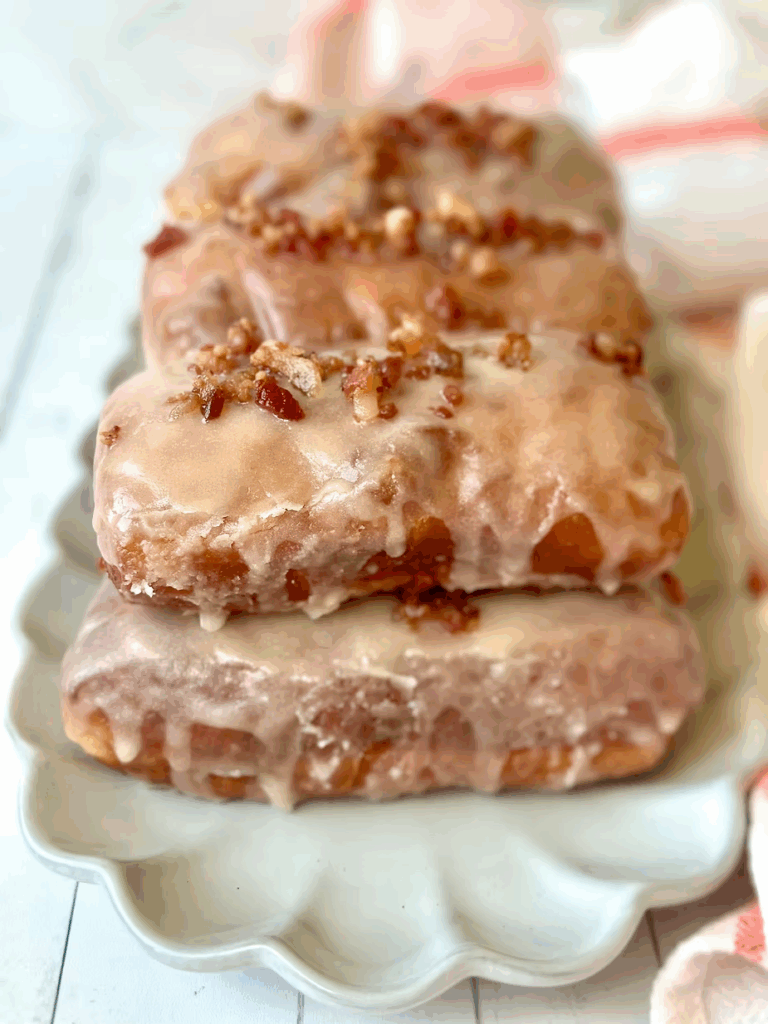
Step-by-Step Instructions
Step 1: Make the Sweet Levain (Night Before)
Baker’s Schedule: 8:00 PM- Night Before

Ingredients:
• 25g (1 Tablespoon) sourdough starter (100% hydration)
• 100g all-purpose flour (¾ cup + 2 tbsp)
• 100 g water (3/4 cup + 2 tbsp)
• 25g granulated sugar (1 tbsp + 2 tsp)
Instructions:
1. Mix all ingredients until a paste forms.
2. Cover and let ferment at 74–78°F (23–26°C) for 10–12 hours, or until doubled and domed.
Step 2: Make the Tangzhong

Baker’s Schedule: 8:00 AM- Day 1
Ingredients:
• 20g all-purpose flour (2 tbsp)
• 100g whole milk (⅓ cup + 1 tbsp)
Instructions:
1. Whisk milk and flour together in a small saucepan.
2. Cook over medium/low heat, stirring constantly, until it thickens into a paste that is similar to pudding (about 2–3 minutes). For precision, use your digital thermometer and heat to 148-155 F. Do not overheat, or your mixture will be too thick.
3. Scrape into a bowl immediately to prevent further cooking, cover, and let cool to room temperature before adding to your dough.
Prepare your dough while tangzhong cools.
Step 3: Mix the Dough
Baker’s Schedule: 8:30 AM- Day 1
In a stand mixer fitted with a dough hook or large mixing bowl, add:
- 275g (1 cup +2 Tablespoons) whole milk
- 200g (3/4 cup) sweet starter
- 1 large egg
- 25g (1 Tablespoon) honey
- 60g (1/4 cup + 1 Tablespoon) sugar
- 1 tsp vanilla extract
- All of the tangzhong paste
Whisk ingredients together quickly, it’s okay if it’s lumpy.
Add in to the wet ingredients:
- 500-550g (4 1/3 cups) bread flour (see notes below)
- 6g (1 teaspoon) fine sea salt
Mix on low until a shaggy dough forms, about 2-3 minutes. Scrape down bowl if needed. If using your hands, knead until you work dough into a ball.
Once dough has formed a rough ball, add:
- 57g (4 Tablespoons) softened butter, a tablespoon at a time
Continue mixing on medium-low (speed 2–3) for 8–10 minutes, until dough is smooth, elastic, and tacky but not sticky. If mixing by hand knead dough until butter has fully incorporated and dough is smooth and tacky.
If kneading in a mixer or if dough is very wet when mixing by hand, add an additional 25 grams (3 Tablespoons) of flour and mix into dough. Make sure to work flour in completely and assess if you need more flour. I did this twice adding in a total of 50 grams (6 Tablespoons) of flour for the dough consistency I liked.
Do not add more than 50 grams of flour at this stage, or you will lose the high hydration of the dough and end up with a dense donut. If using a stand mixer, dough can become more warm and sticky and I have found kneading dough with my hand (perform a set of stretch and folds) for a minute after mixing really helps bring the dough together.
Step 4: Bulk Fermentation
Spray a clean bowl with oil. Shape the dough into a smooth ball and place it in the bowl. Cover with plastic wrap.
If you used a stand mixer, perform one set of stretch and folds after 30 minutes to strengthen your dough. If you mixed dough by hand, perform 3 sets of stretch and folds at 30 minute intervals at the beginning of bulk fermentation. After stretch and folds are completed, cover dough and allow to continue proofing.
Let dough rise at 75–80°F until doubled in size—about 5–6 hours. If your house is very cold, you can put dough in the oven with the light on for a warmer atmosphere.
Once dough has finished rising, you can cover and transfer to the refrigerator overnight for a longer ferment or you can skip this step and go straight to cutting out your donuts. I do find it to be easier to shape the donuts when the dough has been refrigerated but it isn’t necessary.
Step 5: Shape the Donuts
Baker’s Schedule- 8:00 AM Day 2 (if doing overnight ferment)
Flour your work surface. Turn out the dough on your surface and flour the top and the rolling pin to avoid sticking. Roll dough to 1/2-inch thickness, forming a 12×10 inch rectangle. The width should be 12 inches, and length 10 inches.

Trim your edges to make a clean rectangle. Cut rectangle in half horizontally, and make 6 cuts diagonally to form 12 bars. Each bar should be roughly 2 inches wide and 5 inches long.
Cut 12 6×4 inch parchment squares. Flour these to prevent dough from sticking. Place each bar onto its own parchment square and transfer to baking sheets. I fit 2 rows of 3 donuts on each pan to avoid overcrowding. The individual parchment squares are highly recommended, as it will give bars a better shape and help you avoid dough sticking to your hands when transferring to frying oil.
Step 6: Final Proof

Cover bars loosely with plastic sprayed with cooking oil and let rise at room temperature for 2–3 hours, or until puffy and jiggly. When poked gently with a fingertip, the dough should spring back slowly—not immediately. Because this dough has the tangzhong to provide stability to the dough, you can push your final proof a little longer to get a really airy donut. It’s better to give this step more time than less.
Step 7: Fry the Donuts
Baker’s Schedule- 11:00 AM Day 2

Line a cooling rack with paper towels. Fit your candy thermometer into your deep pot. Transfer 3–4 cups of organic coconut oil to a deep pot or Dutch oven, and heat to 350-360°F on medium heat. If oil gets hotter than this, reduce heat accordingly. Watch your temperatures very closely and adjust your heat as needed to avoid burning donuts.
When oil is ready, transfer 2 donuts with parchment paper into oil (you can remove paper with tongs when it separates). If you didn’t use parchment paper, slightly oil your hands with cooking spray and gently transfer donuts to oil.
Fry 30 seconds at a time per side, flipping donuts gently using chopsticks or a slotted spoon. I repeat this step a few times rotating donuts to avoid burning. Remove after a 2-3 minutes with a slotted spoon or spider spoon and donuts are a golden brown. Remove and transfer to a rack lined with paper towels to cool.
Repeat until all donuts have been fried. Allow to cool while you prepare the glaze.

Step 8: Make the Maple Glaze
In a small saucepan over low heat, combine:
• 2 1/2 cups (300g) powdered sugar, sifted
• 1/4 cup (57g) cream ( Note: substituting with milk will make icing thinner)
• 4 tablespoons (57g) salted butter
• 1/4 cup (60g) pure maple syrup
• 1/2-1 teaspoon maple extract (optional but enhances flavor)
• 1 teaspoon vanilla extract
Stir until completely smooth and just warm to the touch. Remove from heat and let cool slightly so it’s thick but still dippable.
Step 9: Glaze the Donuts

Dip cooled donuts face-down into glaze. Remove from glaze and let excess drip off, then transfer back to an unlined wire rack. After donuts have cooled for roughly ten minutes, dip face-down again to coat with more glaze if desired.
Sprinkle donuts with 1/3-1/2 cup bacon crumbles on freshly glazed donuts.
Let glaze set for 30–45 minutes before serving.
And the last thing to do is brew a fresh cup of coffee to enjoy with your warm glazed Sourdough Maple Bacon Bars!
Yields 12 bars
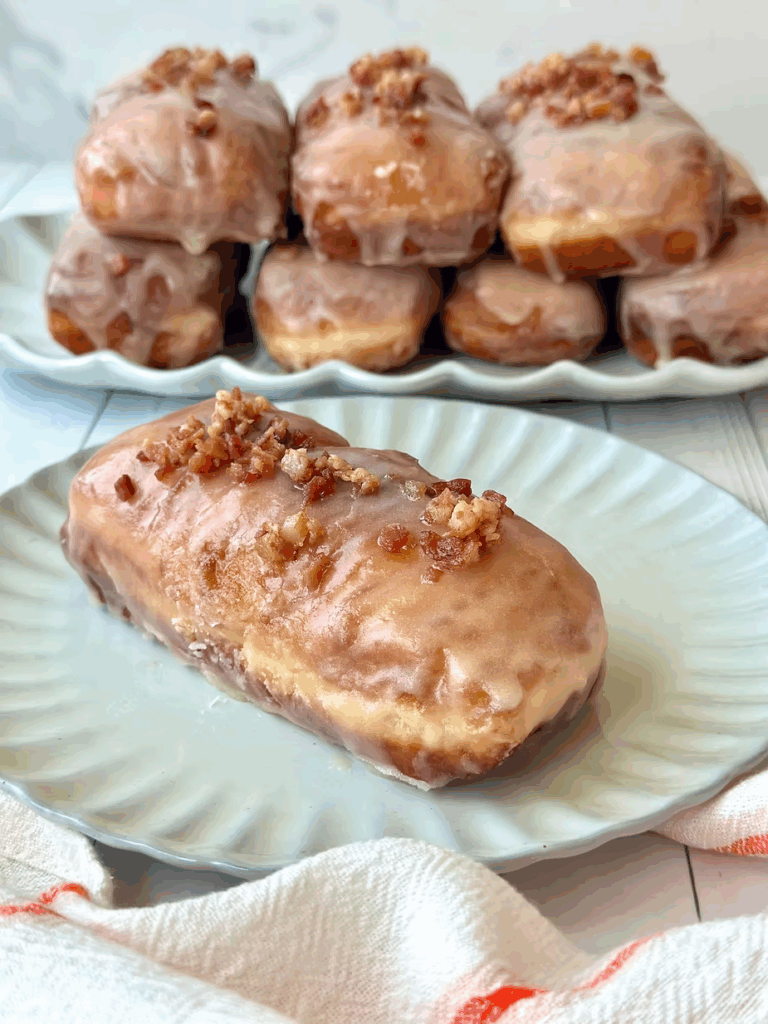
Storing Tips:
- These are best served fresh, but you can store in a single layer in an airtight container for enjoying the next day.
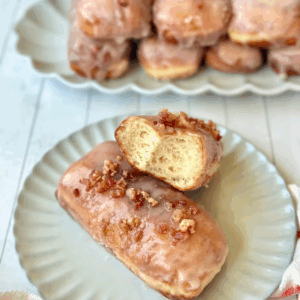
Sourdough Maple Bacon Bars
Equipment
- Stand mixer (optional)
- 1 medium saucepan for mixing tangzhong
- 1 medium pot for glazing donuts
- 1 Deep pot or Dutch oven for frying donuts
- Kitchen scale for precise measurements
- Measuring cups and spoons
- Rolling Pin for rolling out donuts
- Pizza wheel or shar knife for cutting donuts
- 12 6×4 parchment squares for proofing and frying donuts
- Frying thermometer to make sure oil is at correct temperature
- Slotted spoon or chopsticks to flip donuts
- 2 Cooling racks for cooling and glazing donuts
- Paper towels to absorb excess oiil
Ingredients
Sweet Levain:
- 2 Tablespoons and 2 teaspoons (25g) granulated white sugar
- 1 Tablespoon (25g) sourdough starter 100% hydration
- 3/4 cup and 2 Tablespoons (100g) water room temperature
- 3/4 cup and 2 Tablespoons (100g) all-purpose flour or bread flour
Tangzhong Paste:
- 2 Tablespoons (20g) all-purpose flour or bread flour
- 1/3 cup and 1 Tablespoon (100g) whole milk
Main Dough:
Wet Ingredients:
- 1 cup and 2 Tablespoons (275g) whole milk
- 3/4 cup (200g) sweet levain can substitute with active 100% sourdough starter but taste may be more sour
- 1 (50g) egg room temperature
- 1 Tablespoon (25g) honey can substitute for white granulated sugar
- 1/4 cup and 1 Tablespoon (60g) white granulated sugar
- 1 teaspoon vanilla extract
- all of the tangzhong paste see notes above
- 4 Tablespoons (57g) unsalted butter, softened
Dry Ingredients:
- 4 1/3 cups (500-550g) bread flour see notes in recipe
- 1 teaspoon (6g) sea salt
Maple Glaze:
- 2 1/2 cups (300g) powdered sugar, sifted do not use granulated sugar glaze will be gritty
- 1/4 cup (57g) cream Note: you can use milk or half and half but glaze will be thinner
- 4 Tablespoons (57g) salted butter
- 1/4 cup (60g) pure maple syrup
- 1-1/2 teaspoon maple flavoring optional: adjust according to taste
- 1 teaspoon vanilla extract
Garnish:
- 1/2 cup (120g) bacon crumbles
Instructions
Make Your Sweet Levain (Night Before):
- Baker's Schedule: 8:00 PM- Night Before2 Tablespoons and 2 teaspoons (25g) granulated white sugar, 1 Tablespoon (25g) sourdough starter, 3/4 cup and 2 Tablespoons (100g) water, 3/4 cup and 2 Tablespoons (100g) all-purpose flour
- Mix all ingredients in a jar until a paste forms.
- Cover loosely and let ferment at 74–78°F (23–26°C) for 10–12 hours, or until doubled and domed.
Make the Tangzhong:
- Baker's Schedule: 8:00 AM- Day 1
- Whisk milk and flour together in a small saucepan.2 Tablespoons (20g) all-purpose flour, 1/3 cup and 1 Tablespoon (100g) whole milk
- Cook over medium/low heat, stirring constantly, until it thickens into a paste that is similar to pudding (about 2–3 minutes). For precision, use your digital thermometer and heat to 148-155 F. Do not overheat, or your mixture will be too thick.
- Scrape into a bowl immediately to prevent further cooking, cover, and let cool to room temperature before adding to your dough.
- Prepare your dough while tangzhong cools.
Mix The Dough:
- Baker's Schedule: 8:30 AM- Day 1
- In a stand mixer fitted with a dough hook or large mixing bowl, add your wet ingredients except the butter.1 cup and 2 Tablespoons (275g) whole milk, 3/4 cup (200g) sweet levain, 1 (50g) egg, 1 Tablespoon (25g) honey, 1/4 cup and 1 Tablespoon (60g) white granulated sugar, 1 teaspoon vanilla extract, all of the tangzhong paste
- Whisk ingredients together quickly, it's okay if it's lumpy.
- Add dry ingredients to your bowl.1 teaspoon (6g) sea salt, 4 1/3 cups (500-550g) bread flour
- Mix on low until a shaggy dough forms, about 2-3 minutes. Scrape down bowl if needed. If using your hands, knead until you work dough into a ball.
- Once dough has formed a rough ball, add softened butter 1 Tablespoon at a time.4 Tablespoons (57g) unsalted butter, softened
- Continue mixing on medium-low (speed 2–3) for 8–10 minutes, until dough is smooth, elastic, and tacky but not sticky. If mixing by hand knead dough until butter has fully incorporated and dough is smooth and tacky.
- If kneading in a mixer or if dough is very wet when mixing by hand, add an additional 25 grams (3 Tablespoons) of flour and mix into dough. Make sure to work flour in completely and assess if you need more flour. I did this twice adding in a total of 50 grams (6 Tablespoons) of flour for the dough consistency I liked.
- Do not add more than 50 grams of flour at this stage, or you will lose the high hydration of the dough and end up with a dense donut. If using a stand mixer, dough can become more warm and sticky and I have found kneading dough with my hand (perform a set of stretch and folds) for a minute after mixing really helps bring the dough together.
Bulk Fermentation:
- Spray a clean bowl with oil. Shape the dough into a smooth ball and place it in the bowl. Cover with plastic wrap.
- If you used a stand mixer, perform one set of stretch and folds after 30 minutes to strengthen your dough. If you mixed dough by hand, perform 3 sets of stretch and folds at 30 minute intervals at the beginning of bulk fermentation. After stretch and folds are completed, cover dough and allow to continue proofing.
- Let dough rise at 75–80°F until doubled in size—about 5–6 hours. If your house is very cold, you can put dough in the oven with the light on for a warmer atmosphere.
- Once dough has finished rising, you can cover and transfer to the refrigerator overnight for a longer ferment or you can skip this step and go straight to cutting out your donuts. I do find it to be easier to shape the donuts when the dough has been refrigerated but it isn't necessary.
Shape The Donuts:
- Baker's Schedule- 8:00 AM Day 2 (if doing overnight ferment)
- Flour your work surface. Turn out the dough on your surface and flour the top and the rolling pin to avoid sticking. Roll dough to 1/2-inch thickness, forming a 12×10 inch rectangle. The width should be 12 inches, and length 10 inches.
- Trim your edges to make a clean rectangle. Cut rectangle in half horizontally, and make 6 cuts diagonally to form 12 bars. Each bar should be roughly 2 inches wide and 5 inches long.
- Cut 12 6×4 inch parchment squares. Flour these to prevent dough from sticking. Place each bar onto its own parchment square and transfer to baking sheets. I fit 2 rows of 3 donuts on each pan to avoid overcrowding. The individual parchment squares are highly recommended, as it will give bars a better shape and help you avoid dough sticking to your hands when transferring to frying oil.
Final Proofing:
- Cover bars loosely with plastic sprayed with cooking oil and let rise at room temperature for 2–3 hours, or until puffy and jiggly. When poked gently with a fingertip, the dough should spring back slowly—not immediately. Because this dough has the tangzhong to provide stability to the dough, you can push your final proof a little longer to get a really airy donut. It's better to give this step more time than less.
Fry The Donuts:
- Baker's Schedule- 11:00 AM Day 2
- Line a cooling rack with paper towels. Fit your candy thermometer into your deep pot. Transfer 3–4 cups of organic coconut oil to a deep pot or Dutch oven, and heat to 350-360°F on medium heat. If oil gets hotter than this, reduce heat accordingly. Watch your temperatures very closely and adjust your heat as needed to avoid burning donuts.
- When oil is ready, transfer 2 donuts with parchment paper into oil (you can remove paper with tongs when it separates). If you didn't use parchment paper, slightly oil your hands with cooking spray and gently transfer donuts to oil.
- Fry 30 seconds at a time per side, flipping donuts gently using chopsticks or a slotted spoon. I repeat this step a few times rotating donuts to avoid burning. Remove after a 2-3 minutes with a slotted spoon or spider spoon and donuts are a golden brown. Remove and transfer to a rack lined with paper towels to cool.
- Repeat until all donuts have been fried. Allow to cool while you prepare the glaze.
Make The Maple Glaze:
- In a small saucepan over low heat, combine glaze ingredients.2 1/2 cups (300g) powdered sugar, sifted, 1/4 cup (57g) cream, 4 Tablespoons (57g) salted butter, 1/4 cup (60g) pure maple syrup, 1-1/2 teaspoon maple flavoring, 1 teaspoon vanilla extract
- Stir until completely smooth and just warm to the touch. Remove from heat and let cool slightly so it’s thick but still dippable.
Glaze Donuts:
- Dip cooled donuts face-down into glaze. Remove from glaze and let excess drip off, then transfer back to an unlined wire rack. After donuts have cooled for roughly ten minutes, dip face-down again to coat with more glaze if desired.
- Sprinkle donuts with 1/3-1/2 cup bacon crumbles on freshly glazed donuts.1/2 cup (120g) bacon crumbles
- Let glaze set for 30–45 minutes before serving.
- Enjoy with your warm glazed Sourdough Maple Bacon Bars!
Notes
- These are best served fresh, but you can store in a single layer in an airtight container for enjoying the next day.
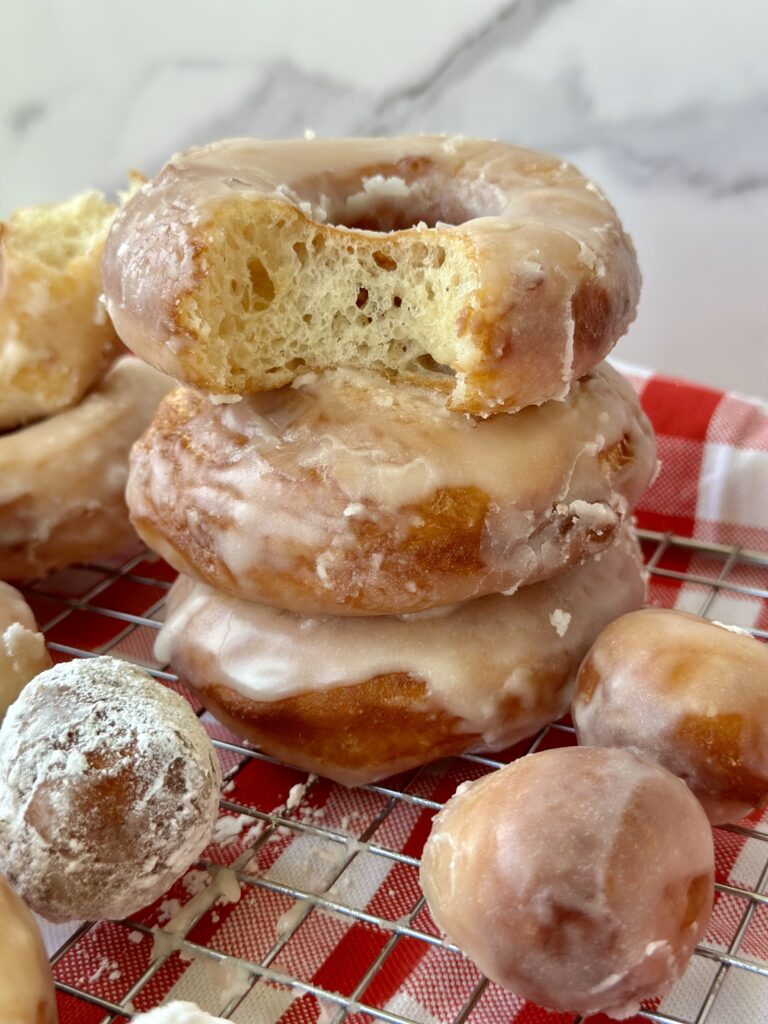
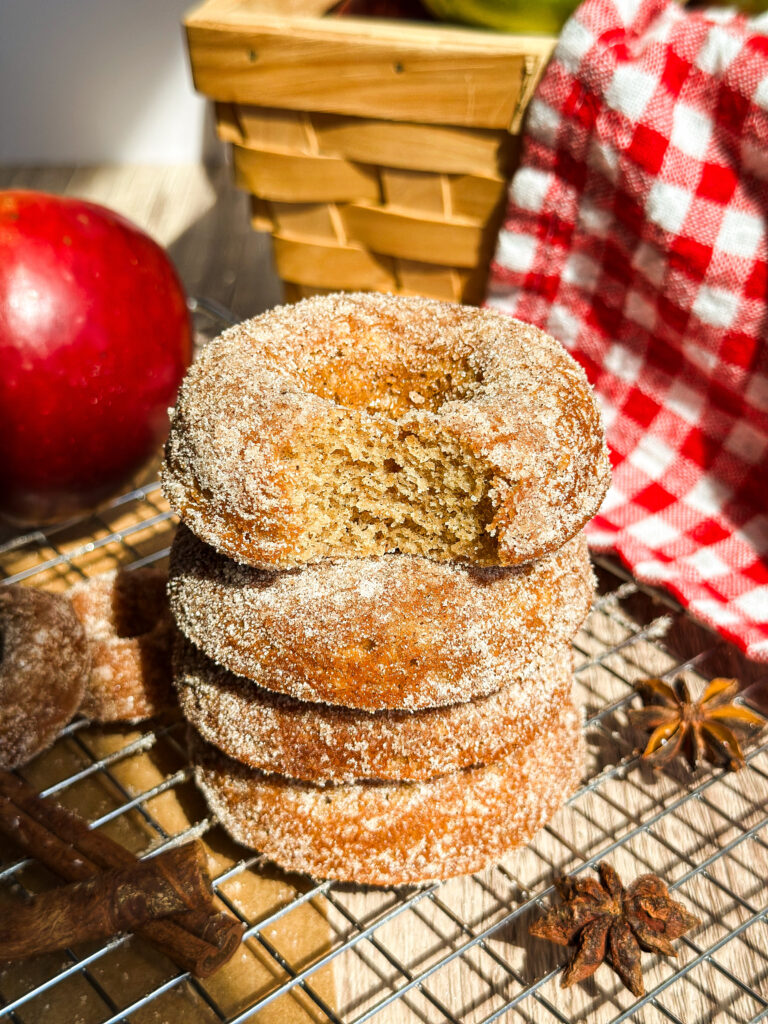
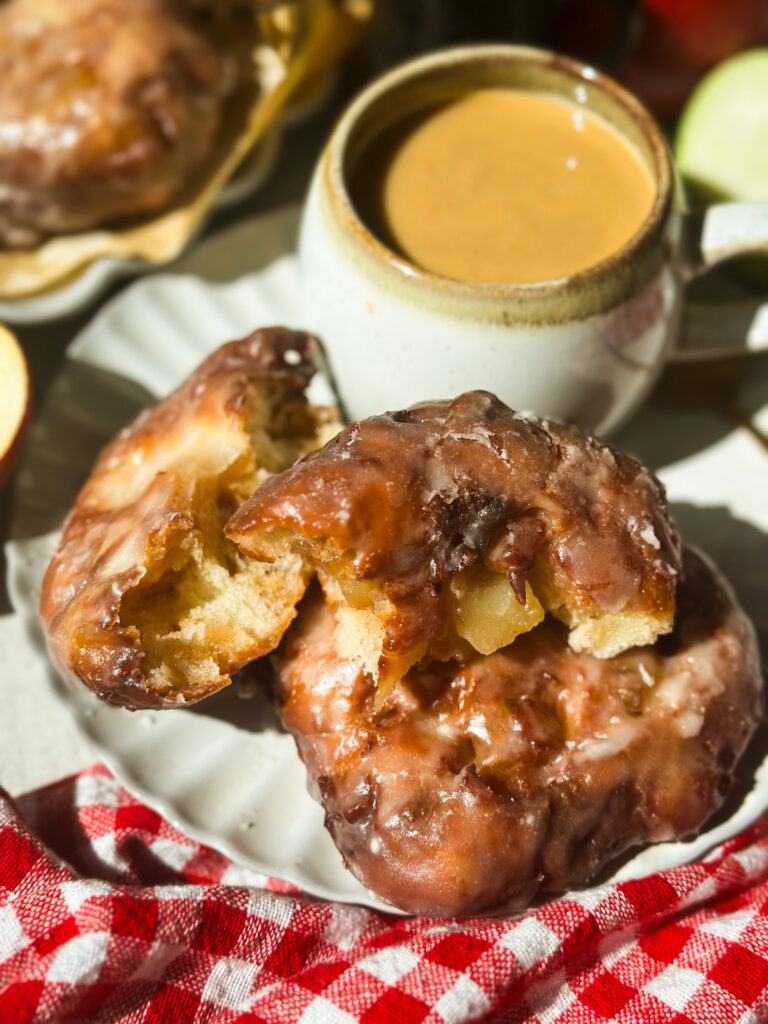
THESE ARE INCREDIBLE!!!! I made these today as a Father’s Day happy and everyone kept raving about them!! The bacon + maple icing complement each other so well and the doughnut was melt in your mouth delicious! Will definitely be making these again. So thankful for Joselyn and all the hard work she puts into these recipes!
I’m so glad these donuts were a hit and the recipe was well loved! Thank you!
There donuts were amazing! My husband loved them for Father’s Day! The photo speaks for itself. I’ll be making these again!
What a gorgeous donut! I’m so happy you loved them! Thank you for the review!